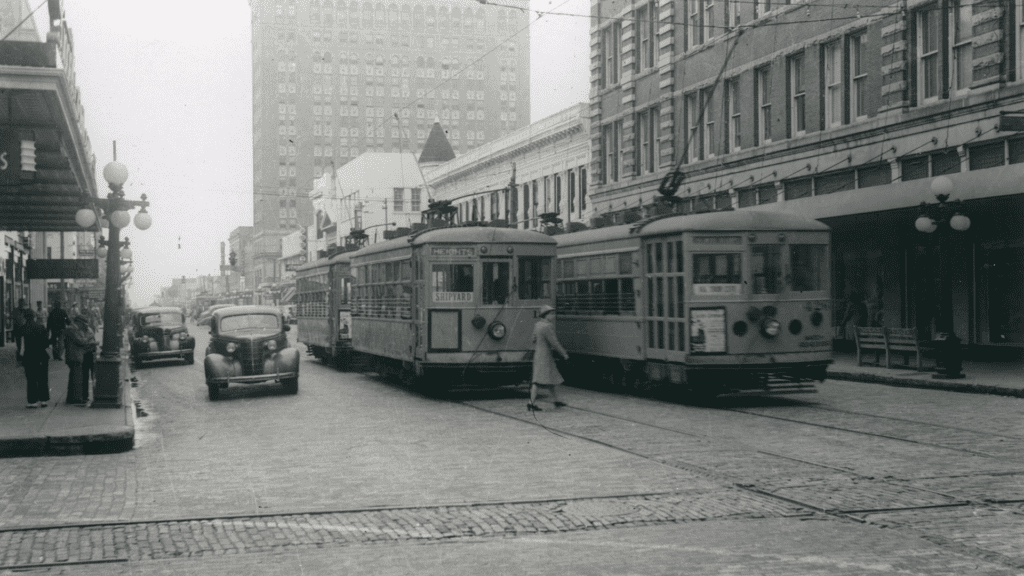Tampa’s historic streetcars

During the last two decades of the 1880s, Tampa was clearly a forerunner for transportation developments in Florida. Through the efforts of the Board of Trade, Tampa had, by 1886, two telegraph lines, railroad and steamship service, and a steam-powered street railway system that carried passengers between Tampa and the new neighborhood of Ybor City.
In 1893, Tampa Street Railway and Power Company converted its steam-powered streetcar system to electric, which sparked a rate war with Tampa’s other streetcar provider, Consumers Electric Light and Power Company.
Consumers temporarily lowered its fares from 5¢ to 2¢, driving the smaller company out of business. The power company then took over Tampa Street Railway’s business, making Consumers the sole supplier of Tampa’s electricity and, with the acquisition of the Tampa and Palmetto Beach Railway Company, the only company providing electric transportation in Tampa.
When Tampa Electric Company (part of today’s TECO Energy) took control of Consumers Electric Light and Power in 1899, the streetcar line consisted of 21.5 miles of track, which carried passengers between downtown, Tampa Heights, Ballast Point, DeSoto Park, Ybor City, and West Tampa – all for a nickel.
The streetcar system grew rapidly during the early 20th century.
Contributing to this was the popular “Birney Car,” named for the Stone and Webster engineer, Charles O. Birney, who designed it. Before using the Birney “safety car,” streetcar lines used “open bench style” cars, allowing riders to get on and off from any point in the car. This proved dangerous, and numerous riders were injured or killed getting on or off the car or simply sticking a limb (or their head) out of the moving car as it passed a light pole. Of the 2,000 or so Birneys built between 1914 and the late 1920s, fewer than 30 survive in museums around the world.
At the peak of the streetcar system’s popularity, over 53 miles of tracks crisscrossed Tampa. The streetcar proved invaluable during World War II when rationing of gasoline and tires meant that families and workers could not rely on their own cars for transportation.
By the end of World War II, Tampa and St. Petersburg were the only Florida cities with streetcars. On Aug. 4, 1946, at 2:15 A.M., the last Tampa Electric Birney car retired to its carbarn on 7th Avenue in Tampa Heights.
Streetcars survive today because of nostalgia, fascination, and community involvement. The old streetcar system’s revival has been taking shape over the past 26 years through the efforts of the Tampa and Ybor City Street Railway Society, Inc.
Dedicated to the preservation and restoration of Tampa’s transportation history and heritage, the Society, with TECO and HART, has returned replicas of Tampa’s yellow streetcars to service, plying the streets between downtown and Ybor City.
Construction of the first phase of Tampa’s new streetcar system began in February 2001 and became operational on Oct. 19, 2002. “The TECO Line” consists of a 2.5-mile track system connecting the downtown Tampa business, convention, and entertainment district to the historic district of Ybor City. The fleet consists of eight replica double truck Birney’s and a “Breezer.”
Phase Two of the new line brings the streetcar north on Franklin Street to Whiting Street and the Fort Brooke Garage. The future is often built on the past, as seen by a partnership with the City of Tampa, HART, TECO Energy, sponsors, and the community; history has repeated itself.
In addition to bringing awareness of the streetcar’s history in Tampa, Railway Society members completely restored an original Tampa streetcar, Birney #163. When the TECO service ended in 1946, the car was sold as a vacation cottage and rested in a backyard in Sulphur Springs, until donated by its owner, Ms. Jeanne MacNeill Mydelski, late in 1991.
Tampa Tank and Welding Company hauled the car to a building where it underwent extensive restoration. The grant-funded restoration, undertaken almost entirely by volunteers, took 12 years to complete. The restored #163 car can now occasionally be seen on the tracks making the run between downtown and Ybor. It is easily recognizable because it is a single-truck Birney, making it much shorter than the other cars. And, true to its history, it doesn’t have air conditioning.
The Tampa Tribune originally published this article on Oct. 30, 2011.


